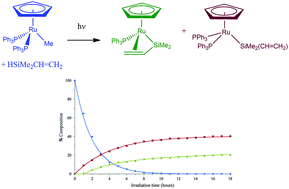Photochemical studies of (η5-C5H5)Ru(PPh3)2Cl and (η5-C5H5)Ru(PPh3)2Me: formation of Si–H and C–H bond activation products†
Abstract
Studies examining the photochemical reactivity of CpRu(PPh3)2Cl and CpRu(PPh3)2Me towards the two electron donor ligands PEt3, C2H4, DMSO, the CH bond activatable reagents tetrahydrofuran, toluene, and pyridine, and the SiH bond activatable reagents HSiEt3 and HSi(Me)2CH![[double bond, length as m-dash]](https://www.rsc.org/images/entities/char_e001.gif) CH2) are presented. Broadband UV irradiation of CpRu(PPh3)2Cl leads to the formation of mono-substitution products such as CpRu(PPh3)(PEt3)Cl which are inert to further photochemical reaction, although thermally bis-substituted products such as CpRu(PEt3)2Cl can be formed. Room temperature irradiation of the related complex CpRu(PPh3)2Me with L = PEt3, C2H4, and DMSO also produces CpRu(PPh3)(L)Me. However, when these reactions are followed by in situ laser irradiation (325 nm source) at low temperature, three solvent activated isomers (ortho, meta and para) of CpRu(PPh3)2(C6H4Me) are detected in toluene in addition to η1- and η3-coordinated benzyl species. Furthermore, photolysis in THF leads to both the C–D bond activation product CpRu(PPh3)2(OC4D7) and the labile coordination complex CpRu(PPh3)(THF)Me. Now CH4 rather than CH3D is liberated which suggests the involvement of an orthometallated species. The photochemically driven reaction of CpRu(PPh3)2Me with HSiEt3 at 198 K generates CpRu(κ2-2-C6H4PPh2)(SiEt3)H and thereby confirms a role for an orthometallated complex is this process. Irradiation in cyclohexane produces the known orthometallated complex, CpRu(κ2-2-C6H4PPh2)(PPh3), and CH4 in accordance with this reactivity.
CH2) are presented. Broadband UV irradiation of CpRu(PPh3)2Cl leads to the formation of mono-substitution products such as CpRu(PPh3)(PEt3)Cl which are inert to further photochemical reaction, although thermally bis-substituted products such as CpRu(PEt3)2Cl can be formed. Room temperature irradiation of the related complex CpRu(PPh3)2Me with L = PEt3, C2H4, and DMSO also produces CpRu(PPh3)(L)Me. However, when these reactions are followed by in situ laser irradiation (325 nm source) at low temperature, three solvent activated isomers (ortho, meta and para) of CpRu(PPh3)2(C6H4Me) are detected in toluene in addition to η1- and η3-coordinated benzyl species. Furthermore, photolysis in THF leads to both the C–D bond activation product CpRu(PPh3)2(OC4D7) and the labile coordination complex CpRu(PPh3)(THF)Me. Now CH4 rather than CH3D is liberated which suggests the involvement of an orthometallated species. The photochemically driven reaction of CpRu(PPh3)2Me with HSiEt3 at 198 K generates CpRu(κ2-2-C6H4PPh2)(SiEt3)H and thereby confirms a role for an orthometallated complex is this process. Irradiation in cyclohexane produces the known orthometallated complex, CpRu(κ2-2-C6H4PPh2)(PPh3), and CH4 in accordance with this reactivity.


 Please wait while we load your content...
Please wait while we load your content...